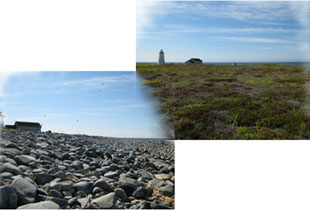 |

|

|

|

|

|
 |
||||
|---|---|---|---|---|---|---|---|---|---|---|
| Physical Characteristics | Natural History | Distribution | In Nova Scotia | Status |
Habitat In Canada, preferred breeding habitat encompasses rocky coastal islands with dense vegetation or artificial shelters in which to hide their nests. Limited information is available concerning wintering grounds although some birds were observed on sandy beaches in Mangue Seco, Bahia, Brazil (Hays et al. 1999*). Here, birds spend most of their day offshore and return only after dusk. |
 |
 |
Food In the northern Atlantic breeding grounds, Roseate Terns forage for small fish including herring, pollock, butterfish and sandlance in shallow, often sandy bays. They will also feed their chicks crustaceans and insects. |
Reproduction Roseates return to their breeding ground, where they have developed strong site fidelity, during early to mid-May. They nest in colonies with Common and Arctic Terns, concealing their nests under grass or driftwood. They will readily use nest boxes or car tires if provided. Incubation begins once the first egg is laid and lasts approximately 23 days. Both parents take part in caring for the young. They fledge around 22 to 30 days but still remain dependant on their parents for food for another 3 weeks. Roseate pairs, which only produce 1 to 2 eggs per year, are slow to reach breeding maturity and quick to abandon a colony site that is disturbed by predators. |
 |
| © 2010, Roseate Tern Recovery Team, All Rights Reserved |